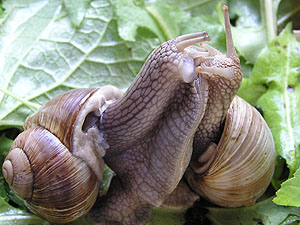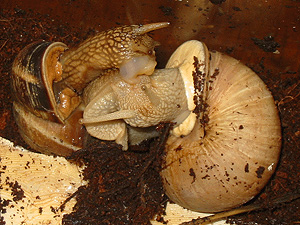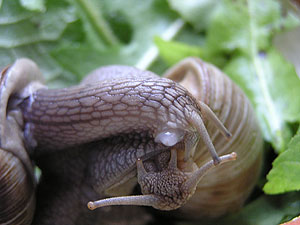| Diese Seite auf Deutsch!! |
|
Courtship and Mating |
 In spring, when the Roman snails are awake from hibernation, the mating season begins. [RN] |
Roman snails are hermaphrodites, like all land snails of the order Stylommatophora, : they possess both male and female organs within a single genital apparatus. This system not only contains the actual reproductive organs but also a variety of auxiliary organs that fulfil specific roles during the different stages of mating.
Why does being a hermaphrodite benefit Roman snails? Because of their proverbial slowness, the range of movement of Roman snails is very small. As with other land snails, their chances of encountering a mate are relatively low.
Hermaphrodites, however, have double the chances of reproduction, since they can mate with any conspecific they encounter. Moreover, copulation can be reciprocal: the snails may not only take turns acting as male or female, but can even function as both simultaneously.
Mating in Roman snails proceeds through several phases lasting many hours, from an initial phase of attraction, through extended courtship, to actual copulation.
 Attraction sometimes passes the borders of species. Helix lu- corum (left) and pomatia (right). Picture: Arno Brosi. |
![]() Inter-species mating between a
Roman snail (Helix pomatia) and a grove snail (Cepaea nemoralis).
Pictures:
Christian Gagelmann.
Inter-species mating between a
Roman snail (Helix pomatia) and a grove snail (Cepaea nemoralis).
Pictures:
Christian Gagelmann.
Although such matings are possible, they do not result in fertile offspring. Hybridisation between closely related species, however, can sometimes lead to sympatric speciation, as is particularly known in door snails (Clausiliidae).
Courtship in Roman snails is fascinating to observe: both snails rise up with their foot soles pressed together and gently sway while touching each other with lips and tentacles. This courtship, with increasing arousal, can last up to 20 hours, while the actual copulation takes comparatively little time.
 This brown garden snail (Cornu aspersum) was hit by two love darts at once. The frontal, smaller one, probably comes from a grove snail (Cepaea nemoralis) living in the same ter- rarium. Photo: Robert Nordsieck. |
Despite the name, the love dart is neither "shot" nor "fired"; it does not fly through the air. Instead, it is thrust like a stiletto directly into the partner's body. Sometimes, however, it misses its target and is left on the ground, and occasionally the snails may even injure each other with it. Not every mating involves the use of a dart; in fact, this is not always possible, since Roman snails mate so frequently that the time between matings may not suffice to produce a new dart.
Research has shown that
the function of the dart is not limited to behaviour. The love dart injects a
secretion from finger-shaped glands containing hormones that influence certain
organs of the partner's genital system, thereby increasing the reproductive
success of the snail that used the dart
![]() : Koene, J.; Chase,
R. (1998).
: Koene, J.; Chase,
R. (1998).
The exact effects of the hormone secretion transferred by the love dart are described together with the respective organs of the genital apparatus.
 It so happens that snails are of a very different enthusiasm during courtship… [RN] |
Eventually, they succeed in finding a position in which actual copulation can take place. The snails extend their long penises, entwine them, and finally insert them into the partner's vagina. Once achieved, both snails remain almost motionless while, within their bodies, a spermatophore is formed.
The spermatophore is thread-like and up to 10 cm long. Even after being transferred into the partner's genital system, its long tail often protrudes from the genital opening. For this reason, both snails remain still until the entire spermatophore, including the tail, has been received. If the snails are forcibly separated during this phase, the spermatophore may be destroyed – rendering the copulation unsuccessful, since successful fertilisation requires complete transfer.
Only then do the two snails part ways, and they may soon mate again. At least part of the foreign sperm is stored in a special sperm storage organ, allowing fertilisation by multiple partners. Fertilisation, however, only takes place later in direct connection with egg deposition (oviposition), once conditions are favourable and a suitable place has been found.